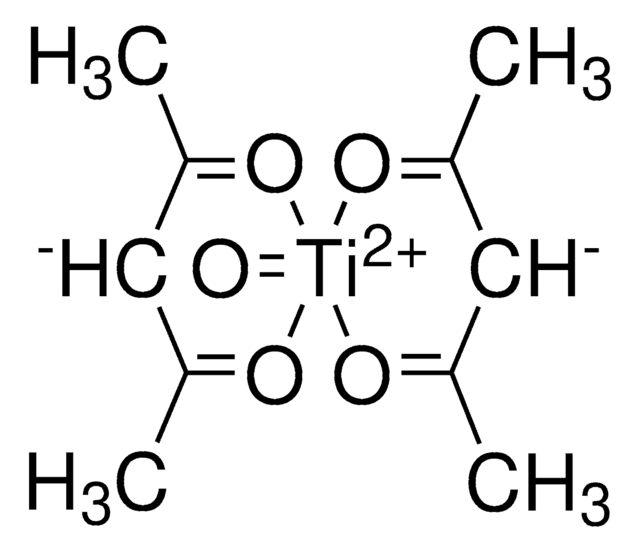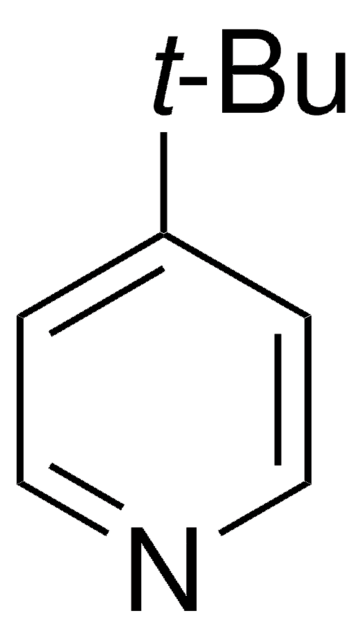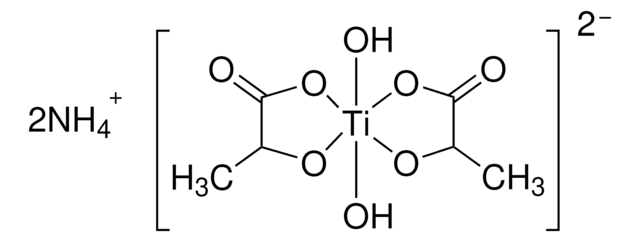325252
Titanium diisopropoxide bis(acetylacetonate)
75 wt. % in isopropanol
Sinónimos:
Diisopropoxytitanium bis(acetylacetonate) solution, TYZOR® AA organic titanate, Ti(acac)2OiPr2
About This Item
Productos recomendados
form
solution
Quality Level
composition
Ti, 9-10.5% gravimetric
reaction suitability
core: titanium
reagent type: catalyst
concentration
75 wt. % in isopropanol
refractive index
n20/D 1.4935
density
0.995 g/mL at 25 °C
SMILES string
CC(C)O[Ti](OC(C)C)(O\C(C)=C\C(C)=O)O\C(C)=C\C(C)=O
InChI
1S/2C5H8O2.2C3H7O.Ti/c2*1-4(6)3-5(2)7;2*1-3(2)4;/h2*3,6H,1-2H3;2*3H,1-2H3;/q;;2*-1;+4/p-2/b2*4-3+;;;
InChI key
OVSGBKZKXUMMHS-VVDZMTNVSA-L
¿Está buscando productos similares? Visita Guía de comparación de productos
Application
Legal Information
signalword
Danger
hcodes
Hazard Classifications
Eye Dam. 1 - Flam. Liq. 2 - STOT SE 3
target_organs
Central nervous system
Storage Class
3 - Flammable liquids
wgk_germany
WGK 3
flash_point_f
53.6 °F - closed cup
flash_point_c
12 °C - closed cup
ppe
Eyeshields, Faceshields, Gloves, type ABEK (EN14387) respirator filter
Elija entre una de las versiones más recientes:
¿Ya tiene este producto?
Encuentre la documentación para los productos que ha comprado recientemente en la Biblioteca de documentos.
Los clientes también vieron
Artículos
New methods for materials fabrication at the micro- and nanoscale will drive scientific and technological advances in areas of materials science, chemistry, physics, and biology. The broad diversity of potentially relevant materials, length scales, and architectures underscores the need for flexible patterning approaches. One important example is the fabrication of 3D periodic structures composed of colloidal, polymeric, or semiconductor5 materials.
Titanium dioxide (TiO2) is an important n-type semiconducting material that shows interesting characteristics such as photoswitchable surface wettability, high photocatalytic activity, bistable electrical resistance states and high electron drift mobility.
Few Monolayer Atomic Layer Deposition (ALD) on Surfaces and Interfaces for Energy Applications
The properties of many devices are limited by the intrinsic properties of the materials that compose them.
Nuestro equipo de científicos tiene experiencia en todas las áreas de investigación: Ciencias de la vida, Ciencia de los materiales, Síntesis química, Cromatografía, Analítica y muchas otras.
Póngase en contacto con el Servicio técnico











